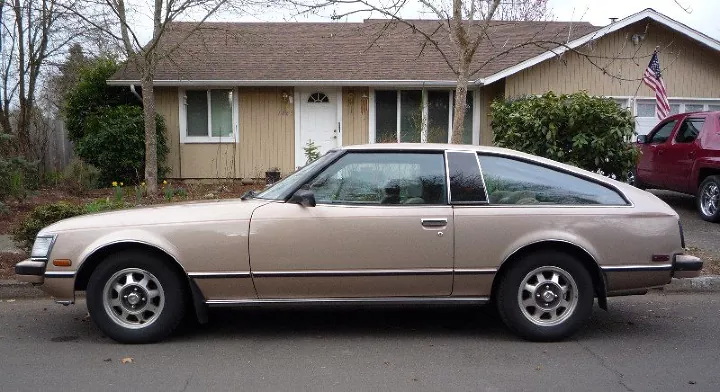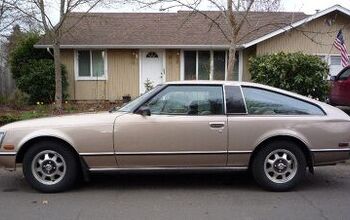Curbside Classic: 1980 Toyota Celica Supra Mark 1

Toyota’s Supra had a rather linear evolution, unlike the Datsun/Nissan Z-car, which lost its way and re-invented itself how many times? Starting out as a soft-sporty coupe with a lazy six borrowed from Toyota’s sedans, it became distinctly sportier and harder-edged with each of its four generations. The final iteration, the turbocharged Supra gen4, has become the stuff of legends and tuners, as in this recent TTAC review. We’re going to take a look at the first three generations this week, so things may start off a little slow, but should be moving pretty quickly by Friday’s wild-looking yellow gen3. Stay tuned!
The Supra started life in 1978 as the Celica XX, a JDM (Japanese Domestic Market) only model, by grafting a 5″ XXL-long front end extension to the Celica, and dropping the venerable 2.0 liter SOHC M-EU inline six. The M series goes back to 1965, and had powered a variety of Toyota sedans, like the Crown and Corona Mk II. In 1979, the renamed Celica Supra appeared on our shores to take up the battle with Nissan’s softified Z car, and Detroit’s emasculated pony cars. The US version came with the larger 2.6 version of the M engine, shared with the Cressida. Despite Toyota’s first application of EFI (Electronic Fuel Injection), it made no more than the JDM 2.0, all of 110 hp.
I tried to find some contemporary reviews of the gen1 Supra on the web, but they’ve all disappeared. I never drove one of these Supras, but my memory tells me that the reviews generally questioned the value of the substantial price increase over the lighter and nimbler four-cylinder Celica. The Supra was a smooth freeway flyer, and most of them came loaded with the automatic, AC, etc. which only added to the front-end mass and dulled its modest sporty ambitions further.
I do have a major soft spot for the un-Supra Celica of this generation, and we’ll take a close look at both the liftback and the coupe versions of them soon. It was a brilliant and clean design; a true standout of its day. But the Supra’s supra-sized nose, and its other distinguishing trim only messes up a balanced and clean design. I resented the gen1 Supra for that, and the fact that it brought nothing even remotely ambitious along with the name and price.
For its final year in 1981, the six was enlarged to 2.8 liters with 116 hp. A Sports Performance Package also became an available option, including sport suspension, raised white letter tires, and front and rear spoilers. The extra six ponies and the SPP hardly turned the Supra into a racer, but it clearly hinted at the direction it was heading in its next incarnation. We’ll take a look at the first step up on Wednesday.
And thanks to getacargetacheck, here’s a vintage Supra ad:

More by Paul Niedermeyer
Latest Car Reviews
Read moreLatest Product Reviews
Read moreRecent Comments
- Theflyersfan OK, I'm going to stretch the words "positive change" to the breaking point here, but there might be some positive change going on with the beaver grille here. This picture was at Car and Driver. You'll notice that the grille now dives into a larger lower air intake instead of really standing out in a sea of plastic. In darker colors like this blue, it somewhat conceals the absolute obscene amount of real estate this unneeded monstrosity of a failed styling attempt takes up. The Euro front plate might be hiding some sins as well. You be the judge.
- Theflyersfan I know given the body style they'll sell dozens, but for those of us who grew up wanting a nice Prelude Si with 4WS but our student budgets said no way, it'd be interesting to see if Honda can persuade GenX-ers to open their wallets for one. Civic Type-R powertrain in a coupe body style? Mild hybrid if they have to? The holy grail will still be if Honda gives the ultimate middle finger towards all things EV and hybrid, hides a few engineers in the basement away from spy cameras and leaks, comes up with a limited run of 9,000 rpm engines and gives us the last gasp of the S2000 once again. A send off to remind us of when once they screamed before everything sounds like a whirring appliance.
- Jeff Nice concept car. One can only dream.
- Funky D The problem is not exclusively the cost of the vehicle. The problem is that there are too few use cases for BEVs that couldn't be done by a plug-in hybrid, with the latter having the ability to do long-range trips without requiring lengthy recharging and being better able to function in really cold climates.In our particular case, a plug-in hybrid would run in all electric mode for the vast majority of the miles we would drive on a regular basis. It would also charge faster and the battery replacement should be less expensive than its BEV counterpart.So the answer for me is a polite, but firm NO.
- 3SpeedAutomatic 2012 Ford Escape V6 FWD at 147k miles:Just went thru a heavy maintenance cycle: full brake job with rotors and drums, replace top & bottom radiator hoses, radiator flush, transmission flush, replace valve cover gaskets (still leaks oil, but not as bad as before), & fan belt. Also, #4 fuel injector locked up. About $4.5k spread over 19 months. Sole means of transportation, so don't mind spending the money for reliability. Was going to replace prior to the above maintenance cycle, but COVID screwed up the market ( $4k markup over sticker including $400 for nitrogen in the tires), so bit the bullet. Now serious about replacing, but waiting for used and/or new car prices to fall a bit more. Have my eye on a particular SUV. Last I checked, had a $2.5k discount with great interest rate (better than my CU) for financing. Will keep on driving Escape as long as A/C works. 🚗🚗🚗







































Comments
Join the conversation
Paul, here's one of the articles on the Mark I I've been looking for: "Supra versus Supra" (by Tony Swan when he was at Motor Trend) which compares the Mark I and Mark II. I can't find the other one from Car & Driver in 1981: "Regal versus Supra." The Regal was probably the Mark I's natural competitor. http://www.geocities.ws/ma71supraturbo/articles/mk2/2_82mtsupra.html
I know the last post here was 4 years ago but i felt i should say something about the MK1 Supra. Having owned both the Celica and Supra variant of this body style i feel i have a unique perspective to offer. I drove an 81 Celica in High School and loved that car. It had the 22R 4 cylinder in it but it got me around just fine. I was always taken back a bit with hits proportions as i felt the front was a bit stubby. That didn't stop me from buying a red 1980 when i saw one come available. Years later after the Celicas were long gone, i decided i wanted the Supra variant as it offered a bit more refinement. I wanted the power windows, multi-port fuel injected 6 cylinder motor and other additions that came with the Supra. It's true the Supra won’t win any races in its stock format but it's a great driver with plenty of pull to get you down the road. The elongated hood was one of the main reasons i wanted this car. I thought it looked better proportionally. I can see that aesthetics are a truly subjective thing. I have my 1980 set up with MK2 wheels and fatter tires to even out its looks. I also have rear and side louvers and the addition of a front air-dam. If the car isn’t all that fast is sure looks fast standing still. In conclusion the MK1 Supra is an undervalued car. It's a great driver that can be modified with the larger MK2 motor for some better performance. It's going to be a sought after car someday. There aren’t many left driving our roads.